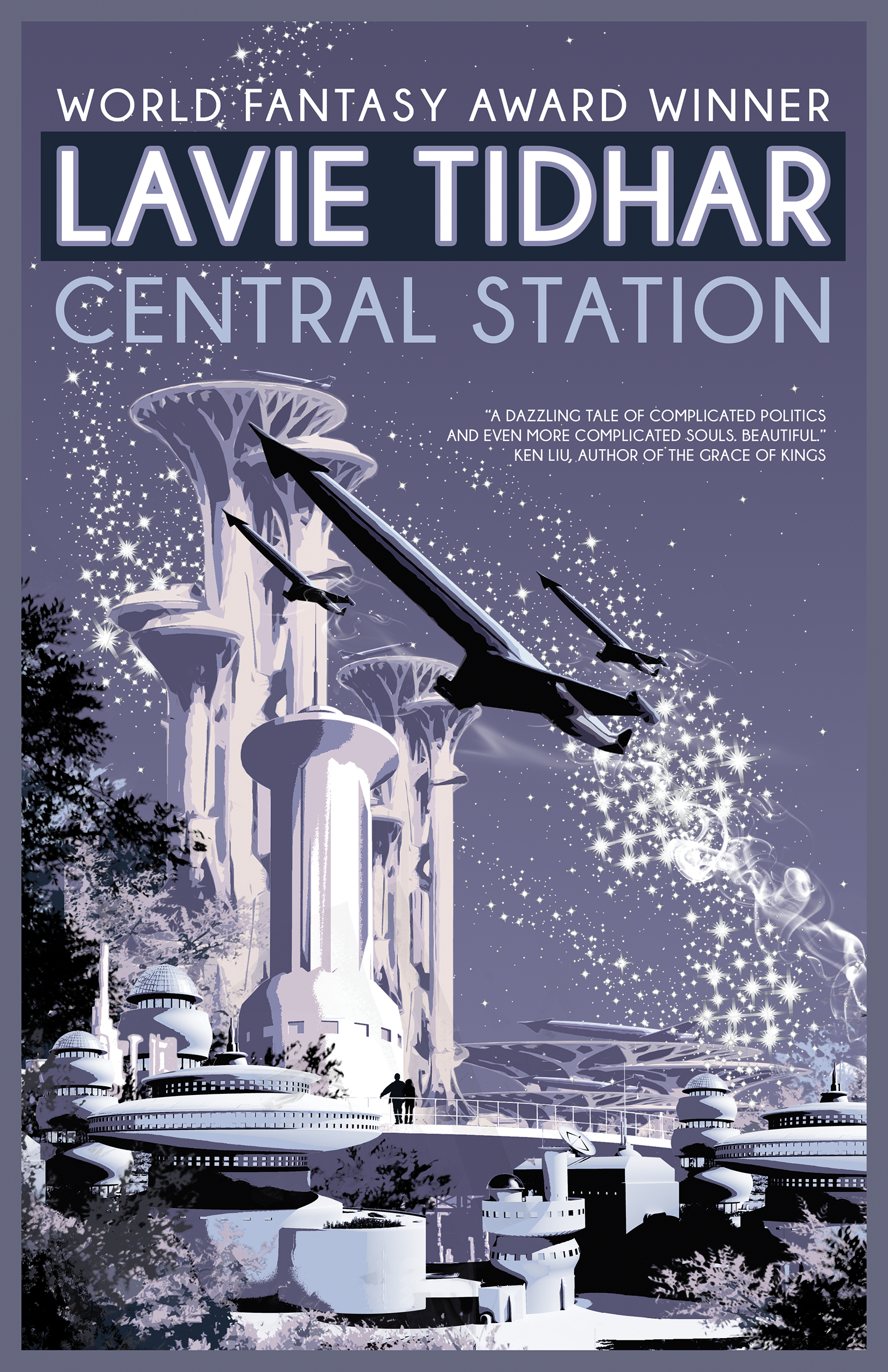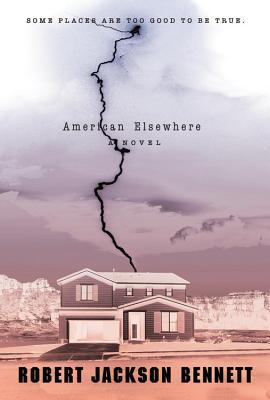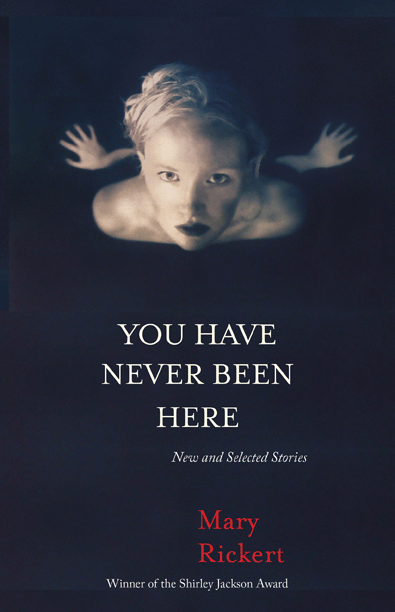What We’re Reading: Central Station

 Central Station by Lavie Tidhar (Tachyon Publications, May 2016)
Central Station by Lavie Tidhar (Tachyon Publications, May 2016)
Central Station takes place on, in, and around an enormous, future space station rising from Earth into space and serving as a hub and launch pad for travelers of the universe. It’s a liminal space, situated in between Jewish Tel-Aviv and Arab Jaffa, and so the station has all the benefits and drawbacks of a transitional, middle space: possibility paired with despair, great potential paired with great failure, the rich moving amongst the poor, celebrities and vagrants, etc. Nearly everyone in this future world is augmented in some way, either through the ubiquitous “nodes” implanted at birth that allow people to access to the great Conversation going on at all times (think every social media feed, YouTube video, and a million, million other pieces of ephemeral, often banal data being broadcast around and into you every second—that’s the Conversation), or through other, more invasive and explicit augmentations (four-armed Martian Reborn, human/robot amalgamations called Robotniks that speak Battle Yiddish, actual robots that practice religion, etc). It’s an eclectic, imaginative population filling a strange and often-recognizable world.
Central Station is an assemblage of vignette-like chapters that shift POV but remain inside and around the titular hub. On the levels of process and history, this makes sense; many of the chapters in the novel have been converted from stories published elsewhere. For many writers, this could lead to something fatuous, a loosely linked set of essays that promise continuity but offer bare contemporaneity. However, Tidhar is magic, and in his hands these individual stories pull life from one another. The novel reads like extended poetry, cycling through descriptions of Central Station or its denizens through the eyes of different characters, expanding and reworking those descriptions and understandings endlessly, a machine cycling through its routines and finding beauty anew in each iteration.
Narrative, in this way, is necessarily fractured in Central Station, but the fracturing creates a sense of momentum and power in the narratives. One for instance, splits the narration between a woman known only as the Oracle (who, we learn, was once named Ruth) and her distant relation, Mark Cohen, who created and bred the Others, entities existing solely in the digital space. Tidhar has some serious work to do in this chapter—it’s near the end of the book, and neither the Oracle nor the Others, despite having both featured in the narrative earlier, are yet clear to the reader. We still have serious questions about how these things work, what their value is to the larger narrative, and what their value is to the micronarrative of the chapter. It’s a lot to accomplish, and Tidhar does it with aplomb, balancing the exposition necessary to grease the narrative wheels with intrigue, emotion, and stories that, despite being set in a scarily distant future, seem real. And true.
The individual chapters and characters are all wonderful—both for themselves and for the larger narrative they come to inhabit and impact. I don’t want to spoil any of that for you, because it’s a real treat to discover the small and large ways things come together, but I do want to talk briefly about one character in particular: Achimwene, a man born without a node or any sort of augmentation. He can’t connect to the Conversation or see the digital world and, fittingly perhaps, he sells ancient, mostly useless artifacts: paper books. Achimwene’s story, without getting too much into the plot, curves away from the banal when he meets Carmel, a strigoi (a data vampire). And Carmel is many things to Achimwene: a mystery, a danger, a love interest. You know the stories (now ubiquitous) about vampires, but here’s the thing: so does Achimwene. This is a man still dependent on narrative to make sense of his life, still, in this fast, digital future, reading pulp novels and imagining himself as the detective or the monster hunter or whatever. He gives us perhaps the most relatable and personal moment in the entire book:
He looked at the things in the box, these fragile, worn, faded, thin, cheap paper-bound books. They smelled of dust, and mould, and age. They smelled, faintly, of pee, and tobacco, and spilled coffee. They smelled like things which had lived.
This is Achimwene’s world, surrounding himself with relics and long-ago stories. And this is where Tidhar’s true mastery reveals itself. Achimwene thinks of himself as being in a love story when he meets Carmel (complete, of course, with all the problems that often come with heteronormative love stories told in pulp fiction), but soon they get it into their heads to investigate Carmel’s origins, to investigate how it was she came to be allowed in to Central Station. In other words, Tidhar tells the reader exactly what he’s going to do; he’s going to switch this narrative from a love story to a mystery, and yet the magic of his trick is not in his telling us this Important and Necessary Stuff about how narratives shape our lives (though, that’s important, too), it’s in his ability get us to believe it. About five or six pages into this new mystery narrative, I was totally hooked. I was into it. I had completely forgotten that the author told me exactly what he was about to do; I was enthralled by the mystery, by the pacing, by the intrigue. Tidhar, in this moment, is like the magician who shows his set-up, tells the audience what the trick is called and how to do it, and then somehow still gets a standing ovation—raucous cheers and joyful tears included—when he does the trick. It’s an amazing moment.
Central Station is a treat. I’ve yet to find a Lavie Tidhar book or story I didn’t love, and this new effort by the author is no exception. It’s due out May 10th. Do yourself a favor and pick it up.
Have you read any excellent books recently by tried and trusted authors?
What We’re Reading: American Elsewhere

 American Elsewhere by Robert Jackson Bennett (Orbit Books, 2013)
American Elsewhere by Robert Jackson Bennett (Orbit Books, 2013)
American Elsewhere is an ambitious novel. The story follows a woman named Mona Bright, who inherits a house in the small, strange, hard-to-find-on-a-map town of Wink, New Mexico. Wink, it turns out, grew up around a high-powered research station that may or may not have gotten into some big, bad stuff (spoiler: it did). We experience this strange, prototypical 50s/60s-style town with Mona, but there are also narratives involving Mona’s mysterious mother, the roadhouse just outside of Wink, Mona’s own fraught relationship with her body and the daughter she almost had, and the odd residents of Wink (who keep dying—like you do).
And yet, bubbling away underneath all of that cool, semi-pulpy plot is a really serious question about how America thinks about its own history, specifically these “good old days” when every home looked like something out of Leave It To Beaver, every man had a car in the garage to work on, and every woman knew how to sew and make great lemonade. Today, we can recognize the huge problems of this vision and world (gender being one of the biggest and most troubling), but American Elsewhere asks us to examine not just how terrible Wink’s image of community and society might be; it also suggests we might still be guilty of romanticizing this version of small-town America—one that Bennett really nicely shows is constructed and contrived.
But how to show this 50s/60s America as problematic? Well, aliens turn out to be American Elsewhere’s approach. I won’t spoil the plot intricacies of how this plays out, but Bennett’s sprawling narrative uses aliens (the creepy, unknown, scary kind instead of the little, green humanoid kind) as a way to leverage this idea that the town Mona finds—the town that has perfectly manicured lawns, a friendly diner everyone attends, and folks just bein’ folks—is manufactured and maintained by a group of beings who saw what America wanted to be and are intent on and addicted to keeping that vision alive.
American Elsewhere is, at its core, a detective story. Mona, who used to be a cop, is putting together the pieces of this town, of her mother’s past, and of the murders that keep happening. And this leads to some very cool investigative moments, one of which is perhaps my favorite in the book. Mona has started to hunt around in the abandoned research station located on top/in a mesa, and she finds video of an experiment featuring the man in charge, Dr. Coburn, and, surprisingly, her mother.
Mona watches the film two more times. Then she starts to look at the records around her.
The reports don’t make any sense to her, and since she has no intention of staying here all night she drops them and moves on.
The tapes, though…the tapes and transcripts are worth something.
After about a half hour of gathering material, she starts playing a couple of the recordings and reading the files.
With a bit more arranging, they start to resemble a story.
This kicks off one of the best chunks of the book, featuring found documents, censored agency reports, and cryptic messages that foreshadow/historicize some bad stuff. This, I think, is where the book truly excels; Bennett is so good at letting the reader participate in the discovery process. The stuff about the aliens is foreshadowed early enough and heavily enough that its reveal is almost banal, but the major events that happened at the research station—the events that thrust everything in this book into motion—those take a more delicate approach to tease out, and it’s a process we get to enjoy.
American Elsewhere is big, complicated, and challenging. There are times when the story slows a little, but never for long, and never without a reason. As someone who lives in a small town that desperately tries, at times, to harken back to a place like Wink, this book was both a great read and a personal one.
What ambitious novels have you been reading recently?
What We’re Reading: The Library at Mount Char
 The Library at Mount Char by Scott Hawkins (Crown Publishing, 2015)
The Library at Mount Char by Scott Hawkins (Crown Publishing, 2015)
The Library at Mount Char, Scott Hawkins’s debut novel, isn’t interested in giving away an easy story. Information and back story are at a premium in this novel, and any bit of stable footing the reader can find is to be cherished. We jump to one-off or two-off POV characters at times, with little to no immediate justification. The story spools out slowly: Carolyn and her siblings, all of whom are adopted, are Librarians, each in charge of his or her own catalog. Carolyn, for instance, is in charge of the language catalog—she learns and studies every language ever spoken or written, including the languages of animals and storms. The kids are adopted at a young age by Father, a being who vacillates between an all-powerful demiurge and a seemingly spiteful parent, playing favorites and imposing his enigmatic will on his children. However, Father has disappeared at the beginning of the novel, which turns out to be both very good and very bad for our characters. What follows is their attempt, shown mostly through Carolyn’s perspective, to find him.
But that isn’t the story. Not really.
There are other narratives, too, of course: the kids all try to fit in with modern America in ways that are at times hilarious and way, way too on the nose. Other characters—Steve, a thief trying to stop thieving and become Buddhist; Erwin, a decorated war hero trying to figure out who Carolyn is—drift into and out of the story, but, for the most part, their narratives are supplemental to Carolyn’s.
The Library at Mount Char is full of the trademarks of really fun fantasy. It has a magical library, which begs a Borges nod, but fits just as well next to the Doctor’s TARDIS or the tents in Harry Potter. And there’s worldbuilding, huge swaths of it, worlds and alternate histories constructed out of nothingness and myth, beasts and lords and monsters from previous eras, beings of immense, arcane power silently battling one another behind the scenes. But Hawkins is sneaky about this worldbuilding; he mentions, he infers, he implies, but he’s abstemious in the actual exposition. He writes a cohesive enough fantasy to imply that there are rules governing it (he even, at times, offers a few of them), but he doesn’t get swept up in the minutiae of those rules.
And the characters all have their own specialties or abilities, all of which come together to create something holistic and complete. A character named David studies the war catalog, and his studies have turned him into a nigh-immortal warrior, lightning fast and deadly with any weapon. Another named Jennifer studies the medical catalog and can heal anything, including death, though she’s gotten a little fond of psychoactive drugs. A character named Margaret specializes in the lands of the dead, and she is often helped out in her trips there by Father:
For a year or so Father had been murdering Margaret two or three times a week. He did this in various ways. The first time he snuck up behind her with an ax at dinner, startling everyone, not least Margaret herself. After that it was gunshots, poison, hanging, whatever. Sometimes it was a surprise, sometimes not. Another time Father pierced her heart with a stiletto, but only after telling her what he would do, setting the knife before her on a silver tray, and letting her contemplate it for three full days and nights. Carolyn would have supposed that the ax would be the worse of the two, but Margaret seemed to take that one in stride. After a day or so of looking at the knife, though, she started to do that giggle of hers. And after that, she never really stopped. Carolyn sighed. Poor Margaret.
You can see the mythical lilt of Hawkins’s story here: the three full days and nights, the sense that all of this has happened before and will happen again, the notion that nothing is forever, nothing is final. Margaret is at once defined and circumscribed here; she’s the girl who goes over to the lands of the dead, and after a little while, all she can do is giggle like a character in a horror movie—exactly what we would expect. Each of the characters has their “thing,” and Hawkins goes so far to identify these characters solely through these “things” that the book moves completely into myth and allegory at times.
But this is where the real cleverness of The Library at Mount Char is. On the surface, this sort of essentialistic characterization sells the book as pretty typical fantasy. A reader could start looking around the fantastical Librarians and saying, “Ok, so you’re the muscle. And you’re the sentimental one. And you’re the brains.” Etc. It’s like a heist movie—assembling the team, tapping certain people for their certain abilities—except with magic! Or powers! Or something! Again, the book is really not too interested in telling us how/why these powers are.
And yet, the true joy of the novel is in the narrative Hawkins has so perfectly embedded in that seemingly basic, mythic story. Because one of these characters isn’t exactly who they say they are. And to really talk about how perfectly, totally well done this is, I have to reveal the character. So if you don’t want the reveal known to you before reading the book, avert your eyes. Go make some tea or play with a puppy or make tea for a puppy or play tee-ball with a puppy or something.
Carolyn, it turns out, knows way more about Father’s disappearance than she’s letting on, but we find out early on that there are characters, some of them Librarians, who can sort of read minds. So Carolyn, our primary POV character, has to hide her knowledge from herself, which leads to some really interesting, really complex situations where Carolyn displaces her knowledge to physical ticks or odd mental tricks, things to distract herself. This is the real story of The Library at Mount Char. It becomes an impressive feat of information manipulation, of inclusion and exclusion, but it’s also an all-in storytelling strategy. Throwing your reader in the deep end at the beginning of a story is typical of a lot of fiction, and it might even be fair to levy criticism on Hawkins for keeping his readers in the deep end for too long. And even if that’s true, I never felt as though Hawkins had lost control of his novel; the strange ticks and errata along the way, the references to characters we never meet and events we never see—all of that stuff comes across as carefully curated clues parceled out by an author in complete control of his story. And when the reveal dawns on the reader, we get to make a joyous retroactive trip, adding up all of those seeming mistakes, running through the list of oddities for which we didn’t previously know how to account.
It may seem like an odd comparison, but I was reminded powerfully of Nabokov’s Pale Fire while reading The Library at Mount Char. Both books feature a cover narrative that slowly peels away to reveal something more insidious, something more complex beneath it. And part of the fun is that peeling away, but part of the fun, of course, is the urge to immediately go back and reread, to experience the book again with a fuller knowledge. And The Library at Mount Char certainly had me wanting to do that.






